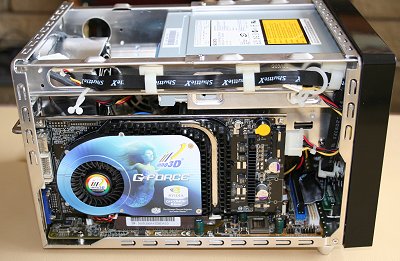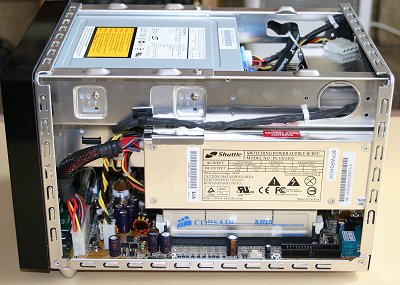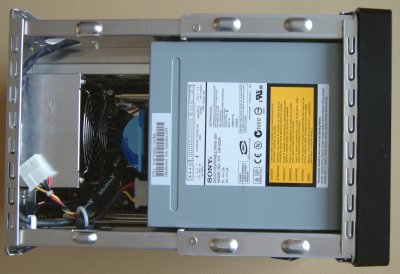Evaluation

Shuttle's SN95G5 can be turned into a wireless wonder by incorporating an optional wireless module into the chassis. If installed, the antenna will show through on the upper left-hand side. MV's obviously geared the GamePro up towards gamers who are as likely as any group to require wireless connectivity. It's a shame, then, that a SFF PC priced at over £1,100 doesn't have it as standard. You can already see the VGA and DVI slots from the GamePro's GeForce 6800 GT card. The chassis keeps things cool by having vents on either side of the removable cover.

Speaking of which, MV uses an Inno3D GeForce 6800 GT 256MB AGP model that's clocked in at 350MHz core and 1GHz memory. Stating the obvious, you can see where the GamePro name comes from. No arguments about its inclusion. The 6800 GT is a solid, high-end card that consistently produces decent performance in a wide range of current games. The SN95G5's single PCI slot is left unoccupied, with sound running from the nForce3 250 Ultra's basic AC'97 integrated audio through Realtek's 6-channel CODEC and out to the jacks on the back. A discrete hardware card would also have been nice at this price, especially as the chipset is so comparatively lacking when compared to its nForce2 APU predecessor.

1GByte of Corsair XMS3200C2PT TWINX RAM, rated at 2-3-2-6 @ DDR400 and run in dual-channel mode, further boosts the Cubik's gaming and performance credentials. However, with the SN95G5 boasting locks for both AGP and PCI buses, synchronous Front-Side bus overclocking may well be limited by the RAM. The reason that overclocking is mentioned is due to the GamePro's AMD Athlon 64 3500+ 90nm CPU. Rated at a nominal 2.2GHz with 512kb of L2 cache, retail examples of this lower-wattage CPU have scaled to 2.5-2.6GHz without the need for esoteric cooling. That makes it an excellent choice for a gamer-orientated cube, as S939 architecture is far better than Intel's equivalent CPUs at all things gaming. Having the ability to raise speeds to near-FX-55 levels, albeit with less on-chip cache, makes it an eminently sensible choice. We'll see just how well this combination of chipset, memory and CPU overclocked a little later on.

Looking down from directly above, we see Shuttle's ICE cooler use a heatpipe-driven approach. The 240w PSU also has a single fan that blows over the CPU area, so cooling, in a small form-factor, has been thought out. MV has taken the barebones SN95G5 and added in a sensible mix of high-spec. components that gel together to form a potent, portable gaming system. Not supplied with our review sample, but shipping with all retail models bought from MV's 'site, is a Logitech MX310 mouse and funky Zboard gaming keyboard, both in matching black. It's nice to see that MV hasn't skimped on input devices. Note that no speakers are shipped with this package. Creative I-Trigue 2.1 are available as a £55 extra. Further, MV offers a media pack upgrade, consisting of Microsoft's Media Centre 2005, a digital TV tuner card, accompanying software and remote control, for an extra £153 inc. VAT.

The associated software bundle is more functional than extravagant. Windows XP Home is slightly cheaper than Professional, and Ability Office 2002 is a poor man's Office XP, although the latter would rarely be specified in an £1,100 machine. Panda Titanium AntiVirus 2005 includes a full 12-month update, and disk-burning software comes in the form of Roxio's Easy Media Creator 7 Basic VCD edition, which is a reasonably comprehensive all-in-one solution. I'd like to see an additional manual, printed on behalf of MV, detailing initial setup and basic Windows' usage, though.
Build quality, both from Shuttle and MV, is excellent. MV offers a three-year limited warranty on the Cubik GamePro. The first year includes on-site parts and labour, with years two and three being return-to-base (RTB) with parts and labour included. That's on a par with most other system integrators.
The main question, therefore, is whether the package is worth it. One method of ascertaining value for money is to add up all the constituent parts, assuming a self-build, and see how competitive MV's price is. Taking this approach, with the specs. listed on the previous page and purchases made from competitive online retailers, the do-it-yourself approach, including software but excluding warranty support and costs incurred in building, would come in at between £950-£1000, depending upon where you shopped. In that context, the £1,127 asking price is pretty reasonable, and it would make sense for all but experienced builders to contemplate a pre-built approach. Of course, building it yourself allows you to define almost every parameter; perhaps a Radeon X800-series card instead, or faster memory, but, as mentioned above, MV's done a decent job in selecting a reasonable mix of performance components. My only real reservation is the relatively weak audio that can only be improved by manually adding in a dedicated card yourself (not an option if the TV tuner option is selected, however.









